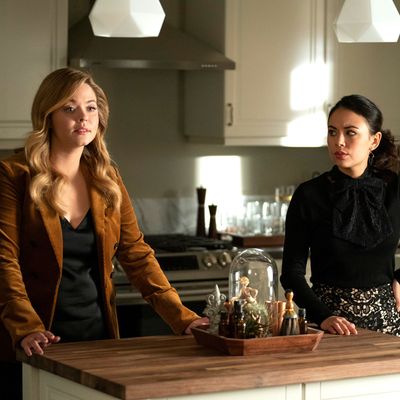
First the torturers, then the victims, and now the lab rats. In a fun twist that unfurled throughout The Perfectionists’ season-one finale on Wednesday evening, the extent of the surveillance surrounding Alison (Sasha Pieterse), Mona (Janel Parrish), and their agonized gang of undergrads was revealed to be some type of grand “experiment” under the watchful eye of “the Professor,” an unknown baddie who’s filling the crime void last left by “A.” What the hell does this person want? And with this specific group of people? Who knows. But by blackmailing them all with evidence of their attempted murder (nobody’s perfect) and getting them to reveal their deepest fears, they’re on track to be part of one of the most sinister collegiate experiments of all time, especially since the school’s psychology department seems to be complicit. We hope this professor has tenure. It’s taking up a lot of energy!
Showrunner I. Marlene King, tight-lipped as always about potential spoilers, was nice enough to give us a brief call to discuss everything that went on in the finale as well as some overarching themes of The Perfectionists and Pretty Little Liars.
When we talked around the time Pretty Little Liars ended, you listed Alfred Hitchcock and Twin Peaks as two of your biggest influences, among many others. I’m curious about how many of these overlap for both shows and what you turned to solely for The Perfectionists.
When we decided to do this show, especially since the books are based in the Pacific Northwest, we still went back to our Edward Hopper references that we used a lot in Pretty Little Liars — but we also wanted to make it a Hitchcockian Northwest feel. I’d say we upped the Hitchcock ante by a significant margin.
When I spoke with Sasha and Janel, they thought of their characters as being an “old married couple” after everything they’ve been through, which gave me a big laugh, especially seeing how this season progressed. Why did you think they were the best fit to expand the PLL universe together?
It’s so true — they really are an old married couple. Not unlike in the original series, nobody can trust anyone in Beacon Heights. Everybody’s a suspect for something. Alison and Mona were very similar characters, and they never really trusted each other. You never really knew which Ali or which Mona you were going to get: the one that’s all better now or the one who can go down the rabbit hole really quickly. The most ambiguous characters are the most intriguing.
You’ve said in the past how you and the PLL writers’ room used to keep a watchful eye on social media for fan reactions, which would in turn influence the show’s progression. Are you continuing to do that now while breaking the second season?
I’ll start by saying we have a lot of fresh faces in the writers’ room as well as a lot of returning younger PLL writers. It’s a great room we’ve created. I think it would be silly not to look at social media, to be honest. It’s the most amazing international focus group you could find to talk about the episodes with. It’s fun to watch with them. I’d be a fool not to take the majority of the opinions.
Okay, we gotta talk about this crazy new villain. I love Mona’s line “You can’t play the game if you don’t know the rules.” How would you characterize the game that’s now afoot with this anonymous professor?
I would define it exactly as Mona does in another quote: psychological warfare. We’re gonna find out more as we progress, like the rules of the game and what the purpose of it is. There is a purpose of the game.
I’m interested in how you wanted to approach technology in The Perfectionists — especially since, at the end of the finale, it’s implied that the group is being tortured not by a peer but an authority figure with a team.
We’re almost 10 years after the original PLL pilot, and technology has changed dramatically in our own world. I’ve always been interested in how it’s a double-edged sword: Technology keeps you safe, but it also makes you incredibly vulnerable. With this show in particular, I want to keep exploring that theme.
Admittedly, I don’t know much about college psychological experiments aside from the Stanford prison experiment, but it’s a nice change in motive for the show to take on.
That’s very different from what we’re presenting, but yeah, actually, we talked about the Stanford prison experiment a lot in the writers’ room. It’s a fascinating experiment with the subjects and researchers. I don’t want to give too much away for fans. We research a lot about these psychological experiments. We thought a lot about what the motivations of this villain would be and the psychological aspects as well. Someone says in the finale, “What are we, human lab rats now?” which sums everything up perfectly.
The other recurring villains in your two shows, who are much less deadly, are female investigators who stalk these teens into as much submission as possible. Alison even says the presence of such a person is her main trigger. Why do you think that type of character is such an effective foil?
For Alison, especially, she really does have a disdain for authority figures, especially those who abuse their power. It’s a great trigger for her to have an onscreen nemesis to push her buttons and everyone else’s buttons, especially since our uber-nemesis will be off-screen for such a long time. It’s very important for a villain to be present.
Saved the most important question for last: How did you choose “the Professor” as the new villain’s moniker?
It was actually a challenge! It really was. We kept thinking, what’s “A” and who’s our “A”? We didn’t want to call it “B” or “X” or “Z.” [Laughs] When we landed on what this villain was about and how to move forward, it felt like the right name. We all cheered as a group when “Professor” was said. It stuck. We had a lot of names along the way, all in the vein of authority figures, but as soon as it was said, we shut it down. For a while, we were calling it “A”, actually. They even say it in the show. Some habits you just can’t shake!


